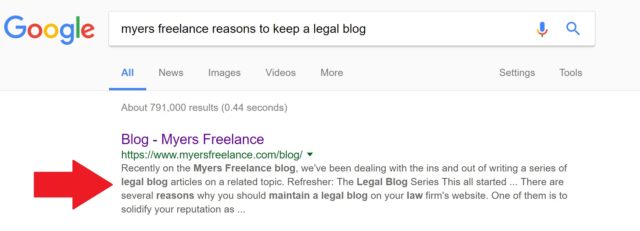We’ve covered meta descriptions on our blog several times in the past, mostly in an attempt to keep up with Google’s waffling over how long they could be. But we’ve never talked about the best ways to write effective meta descriptions for your online legal content.
Here are 13 meta description facts and best practices.
1. Meta Descriptions Come Below the Link in the SERP
Just so we’re on the same page, here: Meta descriptions are the couple of lines that appear below the link to your webpage in the search engine results page (SERP):

Google has taken to calling these lines of text the “snippet” rather than a “meta description.” The change in terms is likely the result of the search engine’s recent willingness to look past the content that you include in your page’s meta description field. Now that Google does not automatically accept your meta description, calling it a meta description would be misleading. Hence, “snippet.”
2. They Don’t Affect SEO But Can Draw Traffic
As we pointed out in an earlier blog post, meta descriptions are not an SEO signal that could boost your page’s rankings in the results page.
A couple of SEO pros disagree with this statement. There aren’t very many of them, and they’re wrong. As this article in Search Engine Journal shows, the evidence they cite is not much more than anomalous statements by Google insiders that could be, but do not have to be, interpreted as an admission that meta descriptions count for SEO points. They also have to ignore numerous other, far more explicit statements by Google personnel that go to the contrary. They also have to ignore the fact that meta descriptions would make for a truly terrible SEO signal: Site owners write them, so they’d be incredibly easy to manipulate with keyword placement.
Just because they don’t directly affect your SEO score, though, does not mean that meta descriptions are meaningless. A good meta description can convince a Google searcher to click on your site when they otherwise might not have. While there is little data to back it up, it is not much of a stretch of the imagination to think that SERP listings with exceptional meta descriptions would outperform their expected click-through-rate (CTR).
Recall that scoring more traffic is the whole point of optimizing your site for search engines.
3. You Have the Power to Write Your Own Meta Description
One of the nicest parts about the meta description is that it is in your power to write it. Most content management systems, like WordPress, have a field to add it when you create a new post, though adding the Yoast SEO plugin makes it easier to use. If you use a web design company that caters to the legal field, like LawLytics or Scorpion, the field for your meta description will be even easier to find.
This is excellent because it gives you the opportunity to write the meta description the way you want it to read.

4. There is Nothing Requiring Google to Use Your Provided Meta Description
However, just because you add your own meta description for a blog post or page does not mean that Google has to use it.
As Google’s documentation for site owners makes clear, meta descriptions “are automatically created from page content.” Site owners, however, can “suggest content” for the description by writing their own using the appropriate HTML tag – something your content management system does behind the scenes when you fill out the meta description field. However, Google claims that it only uses the meta descriptions that you write “if we think they give users a more accurate description than can be taken directly from the page content.”
5. Google Chooses a Meta Description from Your Content Most of the Time
The language in Google’s documentation is quite strong, and implies that it thinks that most of the meta descriptions that will appear in the results page will come from the page, itself. In other words, Google says that the meta description that you provide about a page is only a suggestion – one that it is often going to ignore.
Data backs this up. One study from 2020 looked at results on the first page for 30,000 keywords, and found that Google did not use the offered meta description 68 percent of the time on desktop devices, and 71 percent of the time on mobile searches.
6. You Should Still Take the Time to Write Your Own
Even though two-thirds of the time it will be ignored, it is still worth it to spend the minimum amount of time that it takes to write a meta description for each of your pages. Leaving it up to the Google Gods is leaving an opportunity to make a good first impression on potential readers (and clients) on the table.
It also doesn’t take long to write one. All you have to do is summarize the page that you just wrote. It often takes less than a minute. If it takes longer, then you may want to reconsider the page that you just created. There’s a good chance that if you’re struggling to encapsulate what it’s about in a couple of lines, then the article straddles multiple issues that are probably better covered with multiple articles.
7. 155 Characters is the Soft Maximum
Meta descriptions are short. Google played around with their length a while back, but seems to have settled on their current length, which tops out around 155 characters. This includes spaces.
This is not a lot of room to work with. For example, the paragraph above has 192 characters. If you go over the maximum, and Google uses what you wrote rather than a passage from the article, your meta description will get truncated in the results page, reducing its impact.
8. Should You Include a Call-to-Action?
Many SEO pros say that your meta description should always include a call-to-action, urging the reader to do a particular thing. At this stage in the marketing funnel, that will manifest in a line to the effect of “click here to learn more.”
But given how little room you have to make an impact in the meta description, is that really the best use of your allotted characters?
We think not.
Rather than waste 20 to 30 characters on an explicit call-to-action, craft the meta description in a way that piques the reader’s interest enough to be one, all on its own. They know how Google works, and that clicking on the link will give them more information.
9. You Should Include Your Targeted Keyword or Phrase
This should come as no surprise, but you should absolutely include the keyword or the phrase that you are targeting with the page. By summarizing the page, you should find that you do this organically and without thinking about it, but it’s worth reviewing what you’ve written to make sure that it’s in there.
And yes, you should include your keyword or phrase even though the meta description is not an SEO factor. The words that are used in the search query – as well as similar words and phrases – appear in boldfaced font in the meta description, drawing the eye of potential readers.
10. You Can Refuse a Meta Description for a Page
If, for some reason, you decide that you don’t want a meta description to appear for your page in the SERP, you can tell Google not to show one by including “nosnippet” in the meta tag for the article.
While there may be unique issues that make this a good idea, we can’t think of any off the top of our head. The meta description is an opportunity to pull potential web traffic onto your site. You would have to have a really good reason for not utilizing it.
11. You Can (Kind of) Control What Google Chooses for a Meta Description
While Google makes it clear that it will take what it believes to be a pertinent passage from the article for the snippet, you can carve out parts of your article and make them unavailable. You can do this by using the HTML tag <span data-nosnippet> </span>. The text between these two tags would be unavailable for use in the meta description.
While this is not a feature that many attorneys are going to find very useful, it can help if you are writing in the question and answer format. If you write the question as a header but then aren’t going to answer that question immediately afterward, you may want to sneak this markup around the interrupting passage. That way, if a search query mirrors the question in the header, the meta description that Google pulls from your article is more likely to be the answer to that question, rather than the text that happens to come after the heading.
12. A Different Meta Description May Appear for the Same Page for Different Searches
As we covered earlier, Google frequently disregards your offered meta description and pulls a line or two from the content on your page that it thinks best summarizes the article for the person doing the search. This means that different search queries could produce different meta descriptions for the same page.
Say you’ve written an article about your state’s shift from contributory negligence to comparative negligence for accidents with shared fault elements. You have one section explaining what contributory negligence is, and another one that describes how comparative negligence works. Someone in your state who searches for “contributory negligence rules” is likely going to see a meta description for the page that is pulled from the contributory negligence section, while someone who searches for information about comparative negligence will likely see a passage pulled from the portion that covers comparative negligence. Google will have seen that the content from these different sections was better for each particular search.
13. All of Your Meta Descriptions Should Be Unique
It is easy to read between the lines and see that you should be writing meta descriptions for all of your pages, and that the summary for each page should be unique. However, the need to do so has increased exponentially now that single domains are getting multiple listings in the SERP, thanks to Google’s new indented search listings.
If your meta descriptions for multiple pages are the same, it eliminates an important way for potential readers to decide which of several pages on your domain is going to have the content they’re looking for. If they visit the wrong page, they are more likely to be unsatisfied by what they find, lowering the odds that you successfully convert that traffic into a client.
This issue is a great example of how precise a good meta description has to be. If multiple pages on your law firm’s website are appearing for a single search query, that means that Google thinks that several are relevant and important to the searcher. If several are relevant and important, then they are probably quite similar to one another, requiring meta descriptions that draw out those differences for interested readers to see before they make a click and, potentially, become disillusioned with your firm.